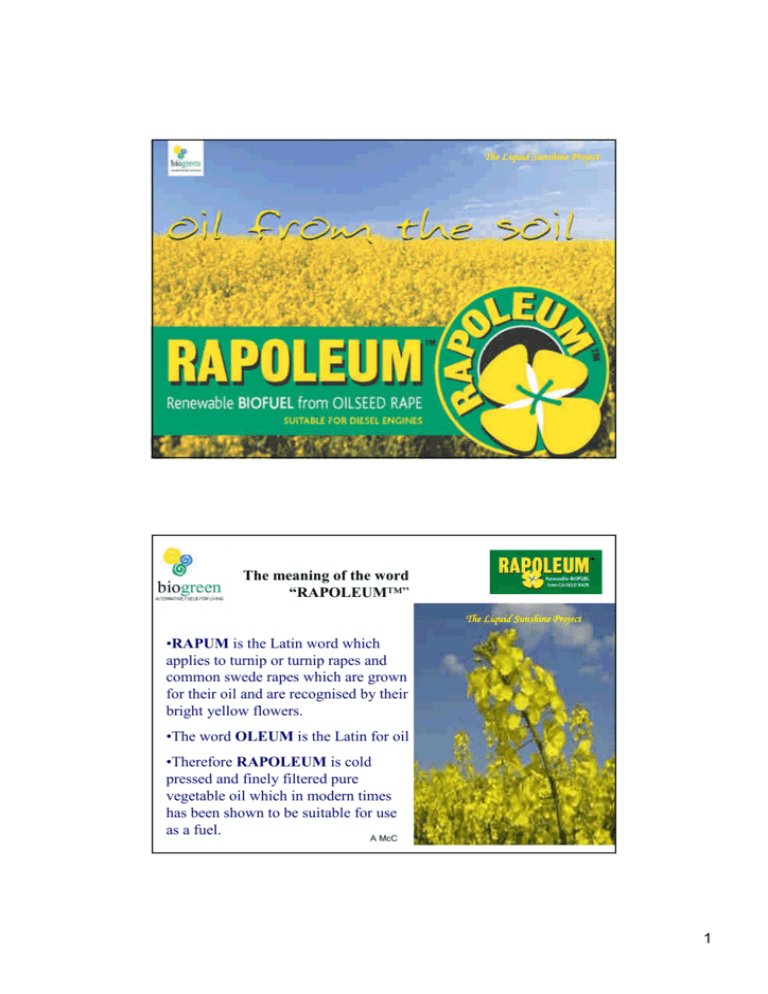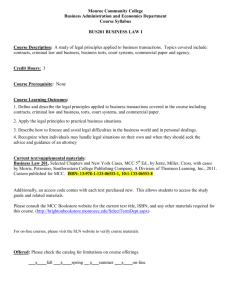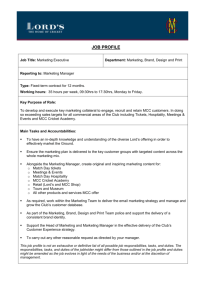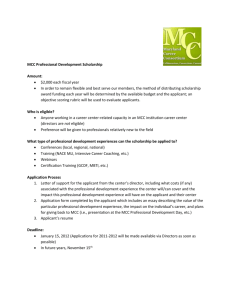1 The meaning of the word “RAPOLEUM ™” •RAPUM is the Latin
advertisement

The Liquid Sunshine Project A McC 1 The meaning of the word “RAPOLEUM™” The Liquid Sunshine Project • RAPUM is the Latin word which applies to turnip or turnip rapes and common swede rapes which are grown for their oil and are recognised by their bright yellow flowers. • The word OLEUM is the Latin for oil • Therefore RAPOLEUM is cold pressed and finely filtered pure vegetable oil which in modern times has been shown to be suitable for use as a fuel. A McC 2 1 Why would we want to produce pure vegetable oil as a fuel? • It is a CO2 neutral fuel so its production and use will help to correct the global warming being caused by the burning of fossil fuels over the past several centuries. • The CO2 content in our atmosphere is the major reason that we can live on our blue planet as without a certain amount of CO2 the global t e mpe r a t ur ewoul dbet ool owf orl i f e“ as we know it”t oe xi s t . A McC 3 Why would we want to produce pure vegetable oil as a fuel? BUT it is possible to have too much of a good thing! A McC 4 2 Why would we want to produce pure vegetable oil as a fuel? The scientific checking of the carbon-dioxide content of our air only properly started in 1958 and it shows a very disturbing trend A McC 5 CO2 Graph ppm Global Co2 400 390 2 R = 0.9994 380 Annual-Fit Trendline - Poly 370 360 350 340 330 320 310 A McC 2009 2007 2005 2003 2001 1999 1997 1995 1993 1991 1989 1987 1985 1983 1981 1979 1977 1975 1973 1971 1969 1967 1965 1963 1961 1959 300 6 3 Why would we want to produce pure vegetable oil as a fuel? • So it is important to try to substitute fossil fuels from a global warming point of view A McC 7 Why would we want to produce pure vegetable oil as a fuel? BUT ALSO • The security and supply of liquid fossil fuels in the next few years has been called into question • Some authorities claim that even now we are at our maximum global production of oil • They say the market will shortly change from a buyers market to a sellers market A McC 8 4 Global Perspective Global oil production will reach a peak sometime during this decade. Af t e rt hepe a k,t hewor l d’ sp r oduc t i onofc r udeoi lwi l lf a l l ,never to rise again. In 1956 the geologist M. King Hubbert predicted that U.S. oil production woul dpe a ki nt hee a r l y1970’ s . Almost everyone, inside and outside the oil industry, rejected Hubberts analysis. The controversy raged until 1970, when U.S. production of crude oil started to fall. Hubbert was right! Ar ound1995,a na l y s t sbe g a na ppl y i ngHubbe r t ’ sme t hodt owor l dc rude oil production, with the results that oil production will peak around 2004. If the predictions are correct (they were correct before!) there will be enormous effects on the world economy. Oil prices will start a relentless upwards spiral as the industrialized A McC nations bid against each other for the dwindling oil supply. 9 Global Oil Production Oil Consumption Million bbl/YEAR 30000 25000 ACTUAL PRODUCTION 20000 "BEST-FIT" MATHEMATICAL PREDICTION 15000 10000 5000 0 1930 1940 1950 1960 1970 A McC 1980 1990 2000 2010 2020 10 5 Energy Supply according to Shell who reduced their proven reserves of oil by 20% since this was released! 18 world energyconsumption [10 J] source: German Shell still open 1500 geo / ocean energy renewable energy solar energy 1000 new biomass wind e nergy waterpower trad. biomass nuclear 500 gas oil coal 0 1900 1920 1940 1960 1980 2000 2020 2040 2060 A McC 11 Why would we want to produce pure vegetable oil as fuel? Further reasons for vegetable oil fuel production • To provide an income source for rural areas • To have the security of a locally produced liquid fuel • To ensure the production of liquid fuels into the far future • To provide some price and supply stability in the liquid fuels supply for transport and agriculture needs • To ease the shock of changing over from fossil fuels onto more sustainable fuels A McC 12 6 Why use rapeseed oil in particular? • I ti si mpor t a ntwi t ha nybi of ue lt ha t“ t heove r a l le f f i c i e nc yof s uppl yi shi g h” • In simple terms - the amount of fossil fuels used in the production of the biofuel should be kept to a minimum • Otherwise it is simply a public relations exercise and not a viable a t t e mptt opr oduc ea“ g r e e n”f ue l A McC 13 Why use rapeseed oil in particular? • The oilseed rape crop has important advantages in this respect • The machinery used in crop preparation and harvesting can be fuelled by Rapoleum™ The Liquid Sunshine Project A McC 14 7 Pure Plant Oil Fuelled Tractors The Liquid Sunshine Project A McC 15 Why use rapeseed oil in particular? Rapeseed produces three products with no waste • Rapeseed oil which can be used as a liquid biofuel • Rape cake which can be used as an animal feed supplement, substituting for imports • Rape straw which can be used as a solid fuel A McC 16 8 The three products Yield Tonnes/hectare Rapeseed Oil Rape Cake Rape Straw 1 2 4.9 A McC 17 Energy content in the products Energy in GJ/hectare 40.76 Rapeseed Oil Rape Cake Rape Straw 56.55 38.64 A McC 18 9 Net Energy 123 GJ/ha Input Energy in GJ/hectare 5.2 4.5 2.1 Fertilizer, Pesticide & Sowing Diesel Fuel Electricity Net Energy Available 123.2 A McC 19 I mpor t antpar ame t e r sf orMaxi mum “Ef f i c i e nc yofSuppl y” • Liquid manure fertilisers should be used where available and crop management should provide minimum use of expensive inputs such as artificial fertilisers and biocides • Renewable energy should be used for the processing and the machinery used in sowing and harvesting the crop should run on the locally produced fuel • Due to the simple methods of production and short transport di s t a nc e st hehi g he s t“ e f f i c i e nc i e sofs uppl y ”r e s ul tf r oml oc a l ly cold pressed rapeseed oil • The higher oil extraction efficiencies of large centralised plants producing biodiesel do not compensate for the higher energy inputs A McC of this process 20 10 THE CARBON CYCLE CO2 nutrients A McC 21 CO2 Neutral • Rapeseed under this system has a strongly positive energy & CO2 balance • Rapeseed oil can be genuinely CO2 neutral because the CO2 reductions from the straw alone far exceed the CO2 emissions used in cultivation and processing • It is important that all three products are utilised to realise the full potential of this production system • The three income streams from the animal feed, liquid fuel and solid fuel products help to improve the economics of the system A McC 22 11 Adapting diesel engines to run on Rapoleum™ Comparison of Major Qualities of Rapoleum™ versus Diesel Fuel Rapoleum™ Diesel Density 0.92 0.86 Cetane Number 51 <49 Energy content in MJ per litre 34.4 35.2 o Flashpoint 325 C 40-55oC o Viscosity at 40 C in cSt 34 2 • It can be seen that as a fuel Rapoleum™ is very comparable with diesel but for its higher viscosity and its much higher flashpoint • The very high flashpoint together with its non toxic nature makes it a very safe product to handle –this is a major plus factor • The viscosity can be altered simply by heating the fuel before it enters the engine A McC 23 Adapting diesel engines to run on Rapoleum™ Rapol eum™ Vi sc os i t y 300 Viscosity cSt 250 200 Near engine coolant temperatures there is little difference in viscosity to diesel at 20oC 150 100 50 1/3 Rapoleum 2/3 Diesel DIESEL 0 -10 0 10 20 30 40 50 60 70 80 A McC Temperature Degrees Centigrade 90 100 24 12 Adapting diesel engines to run on Rapoleum™ • So in order to adapt the engine to burn Rapoleum™ is necessary to heat the fuel Further technical modifications are necessary such as: • Injector nozzles changes to suit new fuel • Some system modifications for start-up when the engine is cold • Modifications to compensate for the thicker fuel being pumped to the engine • Additional adaptation of the engine management system to successful A McC run on Rapoleum™ 25 Adapting diesel engines to run on Rapoleum™ There are many companies offering modification kits so we looked for the following points in selection of a kit: • Excellent technical expertise • Relatively modest cost • An example of best practice in the field • Highly recommended by our technical advisors during our R&D trips to Bavaria in Germany A McC 26 13 Conversion Kit A McC The parts of a pre-combustion chamber engine conversion kit 27 ELSBETT A McC 28 ELSBETT 14 ELSBETT Pure Plant Oil FueledLocomotive A McC 29 Adapting diesel engines to run on Rapoleum™ A McC 30 Rapeoil content in Blend 15 Oil Standard A McC 31 ELSBETT Comparison between Rapoleum™Fueled cars and Electric Cars The Liquid Sunshine Project Comparison Rapoleum versus Electric Car 1357 Range km 100 2200 Energy Onboard kWh Fuel Tank kg 10 230 0 Rapoleum Car Battery Car 12 300 Battery kg Motor & Gearbox kg 70 128 250 250 Chassis etc kg 200 700 1200 A McC 1700 2200 32 16 Adapting diesel engines to run on Rapoleum™ Full modification for running a diesel engine on pure vegetable oil Includes: • New injector nozzles • New glow plugs • New heat exchangers • Pipes, cables & fittings • Engine will run on Rapoleum™, ordinary diesel, bio-diesel or any blend of these fuels A McC 33 Our Production Plant A McC 34 17 Production Plant Layout FEED HOPPER SEED STORAGE HOPPER PRESS CLEANER AUTOMATIC FILTER MAGNET TRAP PELLET DIE RAW OIL TANK CLEAN OIL FINAL FILTER CONVEYOR EXPELLER CAKE PELLETS RAPOLEUM™ OIL TANK TANK A McC 35 A McC 36 Automatic Filter Diagram 18 A McC 37 Co-generation Plant fitted to a house in Germany fueled by cold pressed rapeseed oil Vegetable oil co-generation system as back up system 9000 kWh/y electricial energy sold to the public grid Additional electrical energy demand bought from the public grid 2000 kWh/y Solar thermal energy for water and heating system Photovoltaics 3.800 kWh/y sold to the grid A McC Heat demand 44 kWh/m²/y Solar architecture 38 19 The Liquid Sunshine Project Thank You for Listening! A McC 39 20



